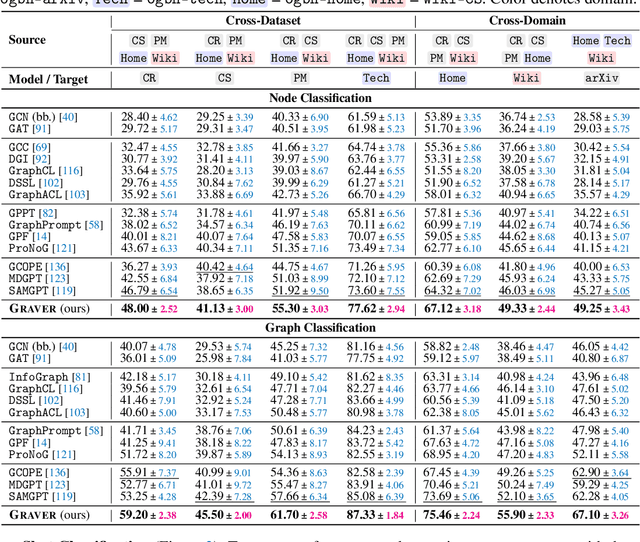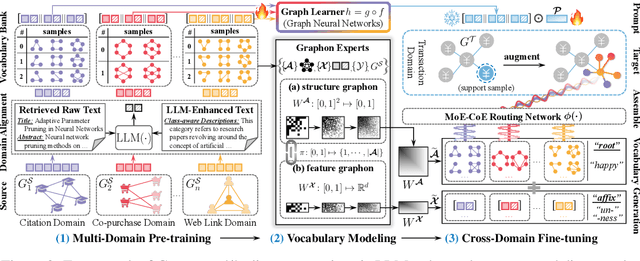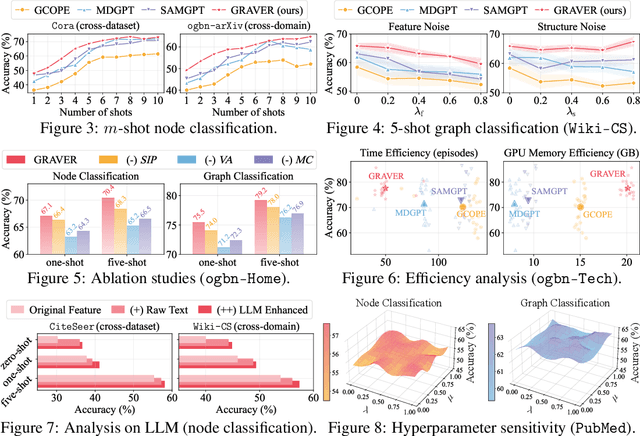Bryan Hooi
Echoless Label-Based Pre-computation for Memory-Efficient Heterogeneous Graph Learning
Nov 14, 2025Abstract:Heterogeneous Graph Neural Networks (HGNNs) are widely used for deep learning on heterogeneous graphs. Typical end-to-end HGNNs require repetitive message passing during training, limiting efficiency for large-scale real-world graphs. Pre-computation-based HGNNs address this by performing message passing only once during preprocessing, collecting neighbor information into regular-shaped tensors, which enables efficient mini-batch training. Label-based pre-computation methods collect neighbors' label information but suffer from training label leakage, where a node's own label information propagates back to itself during multi-hop message passing - the echo effect. Existing mitigation strategies are memory-inefficient on large graphs or suffer from compatibility issues with advanced message passing methods. We propose Echoless Label-based Pre-computation (Echoless-LP), which eliminates training label leakage with Partition-Focused Echoless Propagation (PFEP). PFEP partitions target nodes and performs echoless propagation, where nodes in each partition collect label information only from neighbors in other partitions, avoiding echo while remaining memory-efficient and compatible with any message passing method. We also introduce an Asymmetric Partitioning Scheme (APS) and a PostAdjust mechanism to address information loss from partitioning and distributional shifts across partitions. Experiments on public datasets demonstrate that Echoless-LP achieves superior performance and maintains memory efficiency compared to baselines.
GRAVER: Generative Graph Vocabularies for Robust Graph Foundation Models Fine-tuning
Nov 05, 2025



Abstract:Inspired by the remarkable success of foundation models in language and vision, Graph Foundation Models (GFMs) hold significant promise for broad applicability across diverse graph tasks and domains. However, existing GFMs struggle with unstable few-shot fine-tuning, where both performance and adaptation efficiency exhibit significant fluctuations caused by the randomness in the support sample selection and structural discrepancies between the pre-trained and target graphs. How to fine-tune GFMs robustly and efficiently to enable trustworthy knowledge transfer across domains and tasks is the major challenge. In this paper, we propose GRAVER, a novel Generative gRAph VocabulariEs for Robust GFM fine-tuning framework that tackles the aforementioned instability via generative augmentations. Specifically, to identify transferable units, we analyze and extract key class-specific subgraph patterns by ego-graph disentanglement and validate their transferability both theoretically and empirically. To enable effective pre-training across diverse domains, we leverage a universal task template based on ego-graph similarity and construct graph vocabularies via graphon-based generative experts. To facilitate robust and efficient prompt fine-tuning, we grave the support samples with in-context vocabularies, where the lightweight MoE-CoE network attentively routes knowledge from source domains. Extensive experiments demonstrate the superiority of GRAVER over effectiveness, robustness, and efficiency on downstream few-shot node and graph classification tasks compared with 15 state-of-the-art baselines.
Enhancing Multi-Agent Debate System Performance via Confidence Expression
Sep 17, 2025Abstract:Generative Large Language Models (LLMs) have demonstrated remarkable performance across a wide range of tasks. Recent research has introduced Multi-Agent Debate (MAD) systems, which leverage multiple LLMs to simulate human debate and thereby improve task performance. However, while some LLMs may possess superior knowledge or reasoning capabilities for specific tasks, they often struggle to clearly communicate this advantage during debates, in part due to a lack of confidence expression. Moreover, inappropriate confidence expression can cause agents in MAD systems to either stubbornly maintain incorrect beliefs or converge prematurely on suboptimal answers, ultimately reducing debate effectiveness and overall system performance. To address these challenges, we propose incorporating confidence expression into MAD systems to allow LLMs to explicitly communicate their confidence levels. To validate this approach, we develop ConfMAD, a MAD framework that integrates confidence expression throughout the debate process. Experimental results demonstrate the effectiveness of our method, and we further analyze how confidence influences debate dynamics, offering insights into the design of confidence-aware MAD systems.
What-If Analysis of Large Language Models: Explore the Game World Using Proactive Thinking
Sep 05, 2025Abstract:Large language models (LLMs) excel at processing information reactively but lack the ability to systemically explore hypothetical futures. They cannot ask, "what if we take this action? how will it affect the final outcome" and forecast its potential consequences before acting. This critical gap limits their utility in dynamic, high-stakes scenarios like strategic planning, risk assessment, and real-time decision making. To bridge this gap, we propose WiA-LLM, a new paradigm that equips LLMs with proactive thinking capabilities. Our approach integrates What-If Analysis (WIA), a systematic approach for evaluating hypothetical scenarios by changing input variables. By leveraging environmental feedback via reinforcement learning, WiA-LLM moves beyond reactive thinking. It dynamically simulates the outcomes of each potential action, enabling the model to anticipate future states rather than merely react to the present conditions. We validate WiA-LLM in Honor of Kings (HoK), a complex multiplayer game environment characterized by rapid state changes and intricate interactions. The game's real-time state changes require precise multi-step consequence prediction, making it an ideal testbed for our approach. Experimental results demonstrate WiA-LLM achieves a remarkable 74.2% accuracy in forecasting game-state changes (up to two times gain over baselines). The model shows particularly significant gains in high-difficulty scenarios where accurate foresight is critical. To our knowledge, this is the first work to formally explore and integrate what-if analysis capabilities within LLMs. WiA-LLM represents a fundamental advance toward proactive reasoning in LLMs, providing a scalable framework for robust decision-making in dynamic environments with broad implications for strategic applications.
ConfTuner: Training Large Language Models to Express Their Confidence Verbally
Aug 26, 2025Abstract:Large Language Models (LLMs) are increasingly deployed in high-stakes domains such as science, law, and healthcare, where accurate expressions of uncertainty are essential for reliability and trust. However, current LLMs are often observed to generate incorrect answers with high confidence, a phenomenon known as "overconfidence". Recent efforts have focused on calibrating LLMs' verbalized confidence: i.e., their expressions of confidence in text form, such as "I am 80% confident that...". Existing approaches either rely on prompt engineering or fine-tuning with heuristically generated uncertainty estimates, both of which have limited effectiveness and generalizability. Motivated by the notion of proper scoring rules for calibration in classical machine learning models, we introduce ConfTuner, a simple and efficient fine-tuning method that introduces minimal overhead and does not require ground-truth confidence scores or proxy confidence estimates. ConfTuner relies on a new loss function, tokenized Brier score, which we theoretically prove to be a proper scoring rule, intuitively meaning that it "correctly incentivizes the model to report its true probability of being correct". ConfTuner improves calibration across diverse reasoning tasks and generalizes to black-box models such as GPT-4o. Our results further show that better-calibrated confidence enables downstream gains in self-correction and model cascade, advancing the development of trustworthy LLM systems. The code is available at https://github.com/liushiliushi/ConfTuner.
Beyond Brainstorming: What Drives High-Quality Scientific Ideas? Lessons from Multi-Agent Collaboration
Aug 06, 2025Abstract:While AI agents show potential in scientific ideation, most existing frameworks rely on single-agent refinement, limiting creativity due to bounded knowledge and perspective. Inspired by real-world research dynamics, this paper investigates whether structured multi-agent discussions can surpass solitary ideation. We propose a cooperative multi-agent framework for generating research proposals and systematically compare configurations including group size, leaderled versus leaderless structures, and team compositions varying in interdisciplinarity and seniority. To assess idea quality, we employ a comprehensive protocol with agent-based scoring and human review across dimensions such as novelty, strategic vision, and integration depth. Our results show that multi-agent discussions substantially outperform solitary baselines. A designated leader acts as a catalyst, transforming discussion into more integrated and visionary proposals. Notably, we find that cognitive diversity is a primary driver of quality, yet expertise is a non-negotiable prerequisite, as teams lacking a foundation of senior knowledge fail to surpass even a single competent agent. These findings offer actionable insights for designing collaborative AI ideation systems and shed light on how team structure influences creative outcomes.
Enabling Self-Improving Agents to Learn at Test Time With Human-In-The-Loop Guidance
Jul 23, 2025Abstract:Large language model (LLM) agents often struggle in environments where rules and required domain knowledge frequently change, such as regulatory compliance and user risk screening. Current approaches, like offline fine-tuning and standard prompting, are insufficient because they cannot effectively adapt to new knowledge during actual operation. To address this limitation, we propose the Adaptive Reflective Interactive Agent (ARIA), an LLM agent framework designed specifically to continuously learn updated domain knowledge at test time. ARIA assesses its own uncertainty through structured self-dialogue, proactively identifying knowledge gaps and requesting targeted explanations or corrections from human experts. It then systematically updates an internal, timestamped knowledge repository with provided human guidance, detecting and resolving conflicting or outdated knowledge through comparisons and clarification queries. We evaluate ARIA on the realistic customer due diligence name screening task on TikTok Pay, alongside publicly available dynamic knowledge tasks. Results demonstrate significant improvements in adaptability and accuracy compared to baselines using standard offline fine-tuning and existing self-improving agents. ARIA is deployed within TikTok Pay serving over 150 million monthly active users, confirming its practicality and effectiveness for operational use in rapidly evolving environments.
Automating Steering for Safe Multimodal Large Language Models
Jul 17, 2025Abstract:Recent progress in Multimodal Large Language Models (MLLMs) has unlocked powerful cross-modal reasoning abilities, but also raised new safety concerns, particularly when faced with adversarial multimodal inputs. To improve the safety of MLLMs during inference, we introduce a modular and adaptive inference-time intervention technology, AutoSteer, without requiring any fine-tuning of the underlying model. AutoSteer incorporates three core components: (1) a novel Safety Awareness Score (SAS) that automatically identifies the most safety-relevant distinctions among the model's internal layers; (2) an adaptive safety prober trained to estimate the likelihood of toxic outputs from intermediate representations; and (3) a lightweight Refusal Head that selectively intervenes to modulate generation when safety risks are detected. Experiments on LLaVA-OV and Chameleon across diverse safety-critical benchmarks demonstrate that AutoSteer significantly reduces the Attack Success Rate (ASR) for textual, visual, and cross-modal threats, while maintaining general abilities. These findings position AutoSteer as a practical, interpretable, and effective framework for safer deployment of multimodal AI systems.
ChineseHarm-Bench: A Chinese Harmful Content Detection Benchmark
Jun 12, 2025Abstract:Large language models (LLMs) have been increasingly applied to automated harmful content detection tasks, assisting moderators in identifying policy violations and improving the overall efficiency and accuracy of content review. However, existing resources for harmful content detection are predominantly focused on English, with Chinese datasets remaining scarce and often limited in scope. We present a comprehensive, professionally annotated benchmark for Chinese content harm detection, which covers six representative categories and is constructed entirely from real-world data. Our annotation process further yields a knowledge rule base that provides explicit expert knowledge to assist LLMs in Chinese harmful content detection. In addition, we propose a knowledge-augmented baseline that integrates both human-annotated knowledge rules and implicit knowledge from large language models, enabling smaller models to achieve performance comparable to state-of-the-art LLMs. Code and data are available at https://github.com/zjunlp/ChineseHarm-bench.
How Does Response Length Affect Long-Form Factuality
May 29, 2025Abstract:Large language models (LLMs) are widely used for long-form text generation. However, factual errors in the responses would undermine their reliability. Despite growing attention to LLM factuality, the effect of response length on factuality remains underexplored. In this work, we systematically investigate this relationship by first introducing an automatic and bi-level long-form factuality evaluation framework, which achieves high agreement with human annotations while being cost-effective. Using this framework, we conduct controlled experiments and find that longer responses exhibit lower factual precision, confirming the presence of length bias. To explain this phenomenon, we empirically examine three hypotheses: error propagation, long context, and facts exhaustion. Our results reveal that facts exhaustion, where the model gradually exhausts more reliable knowledge, is the primary cause of factual degradation, rather than the other two hypotheses.
 Add to Chrome
Add to Chrome Add to Firefox
Add to Firefox Add to Edge
Add to Edge